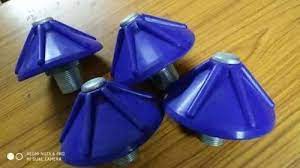Get In Touch
Get In Touch




Aeration pads are simple yet effective devices used in various industries to improve the flow and handling of dry bulk materials, such as powders, granules, and solids. These pads consist of a rubber or synthetic material with a network of small perforations or nozzles that allow compressed air to be injected into a storage vessel, silo, hopper, or chute. When the compressed air is released through these perforations, it creates a series of controlled air bursts, effectively aerating and fluidizing the stored material. This action prevents material blockages, promotes consistent flow, and enhances the efficiency of material handling and discharge processes. Aeration pads are invaluable in ensuring the smooth and reliable handling of bulk materials in various industrial applications.
Material:Aeration pads are typically made from durable materials such as rubber, synthetic elastomers, or food-grade silicone, chosen based on the application's requirements and the material being handled.
Operating Pressure: The recommended operating pressure for aeration pads generally ranges from 4 to 6 bar (58 to 87 psi). However, this can vary based on the specific application and material characteristics.
Size and Shape: Aeration pads come in various shapes and sizes, with common shapes being round or square. The choice depends on the design of the storage vessel or hopper.
Number of Nozzles: Aeration pads may have multiple perforations or nozzles on their surface, and the number and arrangement of nozzles can vary. The selection depends on the material's flow characteristics and the vessel's size.
Nozzle Diameter: The diameter of the nozzles can range from a few millimeters to several centimeters, determined by the material's properties and the desired level of aeration.
Mounting Type: Aeration pads can be welded, bolted, or cemented onto the vessel's surface or within the material flow channel.
Operating Temperature: Aeration pads are designed to withstand the operating temperature of the specific application, which can range from -40°C to 200°C (-40°F to 392°F) or more.
Material Compatibility: Aeration pads must be compatible with the material they come into contact with, especially in industries like food and pharmaceuticals.
Certifications: Depending on the application and industry, aeration pads may need to comply with specific standards and certifications, such as FDA approval for food-grade materials.
Accessories: Some aeration pads may come with accessories such as mounting brackets, solenoid valves, and filters to enhance their performance and ease of installation.
Maintenance Requirements: Manufacturers may provide information on recommended maintenance intervals and procedures to ensure consistent and efficient performance. Installation Guidelines: Instructions for the correct placement, spacing, and orientation of aeration pads to achieve optimal results in different material handling scenarios.
1. Bulk Material Handling: Aeration pads are used in silos, hoppers, and bins to prevent material blockages and ensure consistent material flow in industries handling bulk materials such as grains, powders, cement, and minerals.
2. Food Processing: Aeration pads are utilized in the food industry to promote the flow of ingredients like flour, sugar, and spices from storage bins to production processes, ensuring a continuous supply for mixing and packaging.
3. Chemical Processing: In chemical manufacturing, aeration pads help maintain the flow of powders, granules, and other dry materials, facilitating precise dosing and blending in the production of chemicals and pharmaceuticals.
4. Plastics and Rubber Industry: Aeration pads are used in material handling systems for plastics, pellets, and rubber to prevent material bridging or rat-holing in storage vessels and extrusion equipment.
5. Agriculture: Aeration pads are employed in agricultural applications to ensure a consistent flow of animal feed, seeds, and fertilizers from storage bins, reducing material wastage and enhancing efficiency.
6. Construction and Cement: Aeration pads help maintain the flow of cement, sand, and other construction materials in storage silos and hopper systems, preventing clogs and ensuring a steady supply for concrete production.
7. Power Generation: In power plants, aeration pads are used to enhance the flow of coal, biomass, and other solid fuels, promoting efficient combustion and reducing downtime.
8. Mineral and Mining: Aeration pads are essential in mining operations to facilitate the flow of materials like ores, coal, and minerals from storage vessels to conveyors and processing equipment.
9. Chemical and Petrochemical: These pads assist in the consistent discharge of materials in the production of chemicals, ensuring accurate and uniform mixing and reaction processes.
10. Waste and Recycling: In recycling and waste management facilities, aeration pads promote the flow of recyclable materials, ensuring a smooth transition through conveyors and sorters.
11. Environmental and Remediation: Aeration pads are used in environmental applications to control the flow of materials like activated carbon and absorbents in air and water treatment processes.
12. Pharmaceuticals: In the pharmaceutical industry, aeration pads help maintain the flow of powders and granules in production and packaging, ensuring precise dosing and consistent product quality.
13. Metallurgy: Aeration pads are used in metal processing to facilitate the flow of materials like metal powders and additives, ensuring efficient blending and alloying.
14. Ceramics and Glass: Aeration pads are employed in the ceramics and glass industry for the controlled discharge of raw materials, enabling precise mixing and forming processes.


